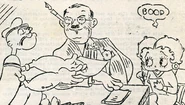
Max Fleischer (1883-1972) was an animator, director, and producer whose Fleischer Studios was one of the leading producers of theatrical animated shorts in the 1920s and 1930s, predating the arrival of Walt Disney. Fleischer helped pioneer the use of rotoscoping (filming and tracing footage of live actors) in its Out of the Inkwell series with Koko the Clown, and was granted the patent on the concept in 1917. He and brother Dave (the original model for Koko, and credited director of most of the studio's output) began their careers at J. R. Bray's studio, establishing their own concern in 1921; following early failed attempts at self-distribution, Paramount Studios became Fleischer's distributor in 1927.
The hallmark of the Fleischer cartoons as they moved into the sound area was rubber-hose movements, with characters limbs stretching and wiggling, a reliance on pop sounds, and a use of New York settings, dialects, and atmosphere. 1930 saw the screen debut of the studio's biggest star, Betty Boop, in primitive form as a canine supporting character in Dizzy Dishes, and by 1932 she was headlining her own series. The studio was also responsible for adapting Popeye to animation in 1933 (introducing him in a Betty Boop cartoon) and establishing the sailor's distinctive voice, the familiar romantic rivalry formula and the reliance on spinach. These cartoons thus departed from the original strip, but set many standards for nearly all later incarnations in print and film.
As Walt Disney and later Leon Schlesinger of Looney Tunes fame arose as competition, the popularity of the Fleischer Studios cartoons gradually waned, while Fleischer continued to experiment with technical methods, notably the "setback", through which cels of characters were photographed before elaborate three dimensional backgrounds, which could be rotated to create a panoramic illusion. In 1938, Max and Dave Fleischer moved their studio to Florida, where they produced their first feature-length film, a loose adaptation of Gulliver's Travels, as well as an assortment of color shorts, the thriving Popeye series, and the final Betty Boop entries. Beginning in 1941, the Fleischers adapted another comics strongman to animation, producing a series of nine Superman shorts. They also produced their second feature, Mr. Bug Goes to Town. Fleischers' mounting debts, and personal and financial bickering between the brothers, forced the sale of their assets outright to Paramount. Following the failure of Mr. Bug, Max and Dave Fleischer were ousted completely, and the studio became the Paramount controlled Famous Studios in 1942, with Max Fleischer's son-in-law Seymour Kneitel taking over as primary director. The brothers now separated, as Dave Fleischer moved to Hollywood to head Columbia Pictures' cartoon studio that year. Max Fleischer joined the Jam Handy studio in Detroit, working on commercials and training films, and produced the first cinematic adaptation of Rudolph the Red-Nosed Reindeer, but soon faded out of the animation business entirely.
Gallery[]
External links[]
- Max Fleischer at the Internet Movie Database
- Lambiek Comiclopedia entry

